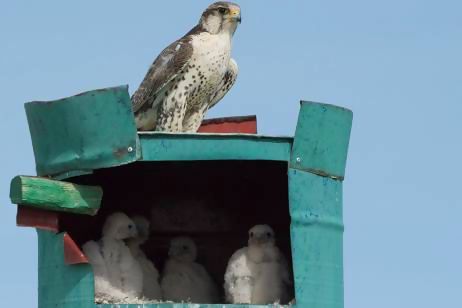ID :
298540
Tue, 09/10/2013 - 10:06
Auther :
Shortlink :
https://www.oananews.org//node/298540
The shortlink copeid
United Nations meeting convenes in Abu Dhabi to take steps to save the Saker falcon

Abu Dhabi: The Saker Falcon Task Force - Stakeholders' Action Planning Meeting convened yesterday in Abu Dhabi, United Arab Emirates, to discuss developments on the Saker Falcon (Falco cherrug) Global Action Plan. The Task Force operates under the auspices of the Convention on Migratory Species (CMS) Memorandum of Understanding on the Conservation of Migratory Birds of Prey in Africa and Eurasia (Raptors MoU). The Environment Agency - Abu Dhabi (EAD) hosts the local United Nations Environment Programme (UNEP)-CMS Office in Abu Dhabi on behalf of the Government of the UAE, and currently services the CMS MoU on the Conservation and Management of Dugongs and the CMS MoU on the Conservation of Migratory Birds of Prey in Africa and Eurasia, following an agreement signed with UNEP in 2009.
Over 50 representatives from Governments, Partners, other stakeholders and interested parties, from more than 30 different countries within the range of the Saker Falcon attend the three-day international meeting.
The Saker Falcon Task Force aims to develop a Saker Falcon Global Action Plan to find long-term solutions for the conservation and management of the species throughout its migratory range that spans over 70 countries. The Task Force is comprised of government officials, international specialists and key stakeholders.
"The Saker Falcon Global Action Plan provides a unique opportunity to promote effective conservation of the species throughout its range," said Nick P. Williams, Head of the Coordinating Unit of the CMS Raptors MoU. "Saker Falcon populations are in serious trouble but by collaborating internationally we can surely improve its conservation status, including by developing robust mechanisms to allow sustainable use for traditional falconry purposes, within an adaptive management framework." The UAE is an important Range State for the Saker Falcon. Mohammed Al Bowardi, Managing Director of the Environment Agency - Abu Dhabi (EAD), said, "Over the last 20 years, the UAE has engaged in a range of innovative ways in which to promote Saker Falcon conservation, including developing initiatives both at home and abroad. The work being carried out to preserve this cultural icon reflects our collective commitment to making a real difference to both the global conservation of and the preservation of our precious biodiversity and natural heritage." Over the past 20 years, the Saker Falcon has suffered major population declines, reducing the number of breeding pairs by almost 50%, due to various threats such as habitat loss and degradation, electrocution by power lines, poisoning, shooting and unregulated trapping for trade for falconry. As a result the Saker Falcon is now classified as globally Endangered by the International Union for Conservation of Nature (IUCN) and was uplisted to Appendix I of the Convention on Migratory Species in 2011. It is also covered by the Convention on International Trade in Endangered Species of Wild Fauna and Flora (CITES) and other multilateral environmental agreements.
The Saker Falcon breeding populations are located in Eastern Europe, Central Asia and as far as Western China. Many Sakers migrate long distances, including through the Middle East to wintering areas situated in North and East Africa. The Saker Falcon is a skilled hunter, particularly adapted to open terrain where its favoured prey is rodents and birds; for this reason, it has long been a popular bird with falconers. Historically Sakers were crucial to the livelihood of some Bedouin tribes, who relied on their trained falcons to capture fresh meat during winter. Even today the species is sought-after, particularly by Arab falconers.
The Convention on the Conservation of Migratory Species of Wild Animals (CMS) is a global biodiversity-related treaty with 119 Contracting Parties. CMS, whose secretariat is provided by the United Nations Environment Programme (UNEP), takes a migratory range approach to species conservation and sustainable use: Migratory species can best be conserved through joint international cooperative efforts, coordinating activities at national levels across their migratory range. It is premised on the idea that countries must work together to conserve and sustainably use migratory species.
The CMS Memorandum of Understanding on the Conservation of Migratory Birds of Prey in Africa and Eurasia (Raptors MoU) is administered by a Coordinating Unit based in Abu Dhabi, United Arab Emirates. It is hosted by the Environment Agency - Abu Dhabi, on behalf of the Government of the United Arab Emirates. The Raptors MoU came into effect on 1 November 2008 and has 44 Signatories (43 countries and the European Union) and 3 Cooperating Partners (BirdLife International, International Association for Falconry and Conservation of Birds of Prey, and the CMS Secretariat). It covers 76 species of migratory birds of prey and extends to over 131 Range States and territories in the African-Eurasian Region. – Emirates News Agency, WAM





